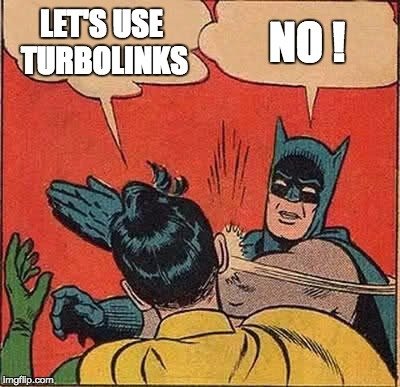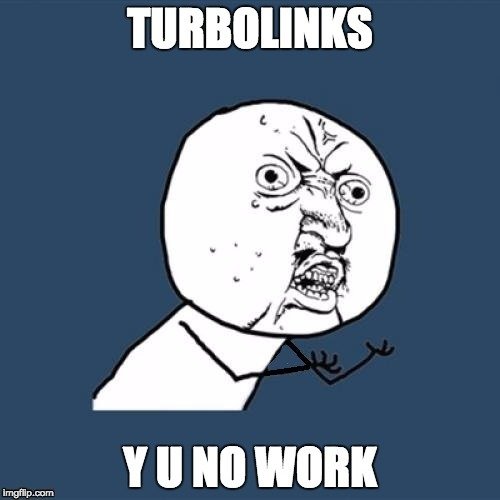Turbolinks 5





Turbolinks 5
Features
- Optimizes navigation automatically
- No server-side cooperation necessary
- Respects the web
- Supports mobile apps
Get the performance benefits of a single-page application without the added complexity of a client-side JavaScript framework.
Who uses it
- SHOPIFY: 100ms
- GITHUB: 65ms
- BASECAMP: 27ms
HTML Rendering
| Time (ms) | Description |
|---|---|
| 10 | network latency |
| 50 | server response |
| 10 | network latency |
| 100 - 700 | parse html, create, render tree ... |
| 300 - 1500 | evaluate javascript |
| 100 - 250 | paint |
View Over the Wire
What is a visit
- Changing browser history
- Issuing a network request (ajax)
- Restoring a copy of the page from cache
- Render final response
Responds with a full HTML response (no JSON)
document.body = xhr.querSelector('body');View Over the Wire
What it does not do:
- Throw away an entire javascript runtime
- Throw away the entire DOM
- Reset the JS global scope
- Parse CSS or evaluate JS from HEAD
Cool Features
One javascript runtime
var audio = new Audio('<%= config[:http_prefix] %>audio/audio_file.mp3');
audio.oncanplaythrough = function(){
$('#player #play').prop("disabled", false);
$('#player #pause').prop("disabled", false);
}
var playMusic = function () {
audio.play();
};
var stopMusic = function () {
audio.pause();
};
$(document).on('click', '#player #play', playMusic);
$(document).on('click', '#player #pause', stopMusic);
<div id="player" data-turbolinks-permanent >
<p>Listen to my awesome music</p>
<button id="play" disabled>Play</button>
<button id="pause" disabled>Pause</button>
</div>Cool Features
data-turbolinks-permanent
var number = 0;
setInterval(function() {
$('#counter p span').text(number);
number = number + 1
}, 1000);
<div id="counter" data-turbolinks-permanent>
<p>Number of downloads: <span>0</span>!</p>
</div>Gotchas
- Implementation
- Good luck with legacy app
- Write your javascript differently
- Event delegation
- Make transformation idempotent
- Global scope
$(document).ready()
- Extra care with third party libraries
- Google Analytics
- Facebook SDK
- Google Maps
Documentation
https://github.com/turbolinks/turbolinks
Resources